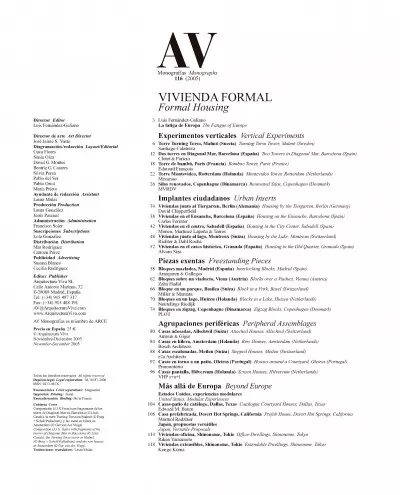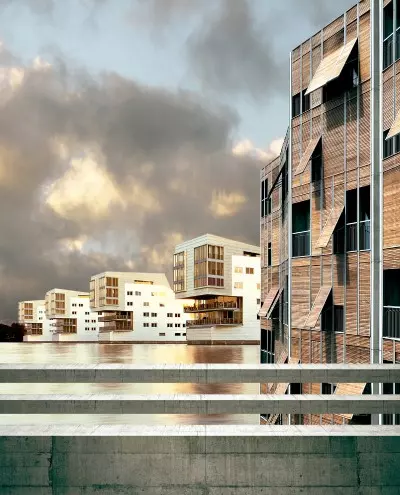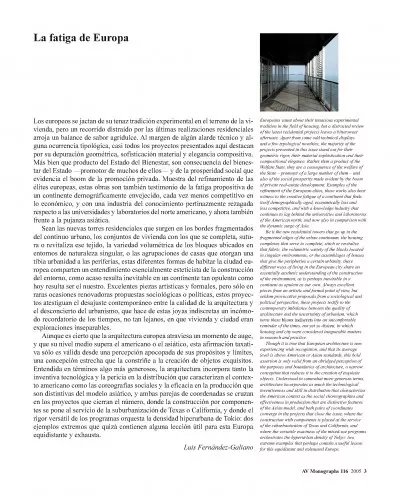VIVIENDA FORMAL
Formal Housing
Luis Fernández-Galiano
La fatiga de EuropaThe Fatigue of Europe
Experimentos verticales Vertical Experiments
Torre Turning Torso, Malmö (Suecia) Turning Torso Tower, Malmö (Sweden)
Santiago Calatrava
Dos torres en Diagonal Mar, Barcelona (España) Two Towers in Diagonal Mar, Barcelona (Spain)
Clotet & Paricio
Torre de bambú, París (Francia) Bamboo Tower, Paris (France)
Edouard François
Torre Montevideo, Rotterdam (Holanda) Montevideo Tower, Rotterdam (Netherlands)
Mecanoo
Silos renovados, Copenhague (Dinamarca) Renovated Silos, Copenhagen (Denmark)
MVRDV
Implantes ciudadanos Urban Inserts
Viviendas junto al Tiergarten, Berlín (Alemania) Housing by the Tiergarten, Berlin (Germany)
David Chipperfield
Viviendas en el Ensanche, Barcelona (España) Housing on the Ensanche, Barcelona (Spain)
Carlos Ferrater
Viviendas en el centro, Sabadell (España) Housing in the City Center, Sabadell (Spain)
Moneo, Martínez Lapeña & Torres
Viviendas junto al lago, Montreux (Suiza) Housing by the Lake, Montreux (Switzerland)
Richter & Dahl Rocha
Viviendas en el casco histórico, Granada (España) Housing in the Old Quarter, Granada (Spain)
Álvaro Siza
Piezas exentas Freestanding Pieces
Bloques maclados, Madrid (España) Interlocking Blocks, Madrid (Spain)
Aranguren & Gallegos
Bloques sobre un viaducto, Viena (Austria) Blocks over a Viaduct, Vienna (Austria)
Zaha Hadid
Bloque en un parque, Basilea (Suiza) Block in a Park, Basel (Switzerland)
Miller & Maranta
Bloques en un lago, Huizen (Holanda) Blocks in a Lake, Huizen (Netherlands)
Neutelings Riedijk
Bloques en zigzag, Copenhague (Dinamarca) Zigzag Blocks, Copenhagen (Denmark)
PLOT
Agrupaciones periféricas Peripheral Assemblages
Casas adosadas, Allschwil (Suiza) Attached Houses, Allschwil (Switzerland)
Amrein & Giger
Casas en hilera, Amsterdam (Holanda) Row Houses, Amsterdam (Netherlands)
Bosch Architects
Casas escalonadas, Meilen (Suiza) Stepped Houses, Meilen (Switzerland)
e2a Architects
Casas en torno a un patio, Oleiros (Portugal) Houses around a Courtyard, Oleiros (Portugal)
Promontório
Casas pantalla, Hilversum (Holanda) Screen Houses, Hilversum (Netherlands)
VHP s+a+1
Más allá de Europa Beyond Europe
Estados Unidos, experiencias modulares
United States, Modular Experiences
Casas-patio de catálogo, Dallas, Texas Catalogue Courtyard Houses, Dallas, Texas
Edward M. Baum
Casa prefabricada, Desert Hot Springs, California Prefab House, Desert Hot Springs, California
Marmol Radziner
Japón, propuestas versátiles
Japan, Versatile Proposals
Viviendas-oficina, Shinonome, Tokio Office-Dwellings, Shinonome, Tokyo
Riken Yamamoto
Viviendas extensibles, Shinonome, Tokio Extendable Dwellings, Shinonome, Tokyo
Kengo Kuma
Luis Fernández-Galiano
The Fatigue of Europe
Europeans vaunt about their tenacious experimental tradition in the field of housing, but a distracted review of the latest residential projects leaves a bittersweet aftertaste. Apart from some odd technical displays and a few typological novelties, the majority of the projects presented in this issue stand out for their geometric rigor, their material sophistication and their compositional elegance. Rather than a product of the Welfare State, they are a consequence of the welfare of the State – promoter of a large number of them – and also of the social prosperity made evident by the boom of private real-estate development. Examples of the refinement of the European elites, these works also bear witness to the creative fatigue of a continent that finds itself demographically aged, economically less and less competitive, and with a knowledge industry that continues to lag behind the universities and laboratories of the American north, and now also in comparison with the dynamic surge of Asia.
Be it the new residential towers that go up in the fragmented edges of the urban continuum, the housing complexes that serve to complete, stitch or revitalize that fabric, the volumetric variety of the blocks located in singular environments, or the assemblages of houses that give the peripheries a certain urbanity, these different ways of living in the European city share an essentially aesthetic understanding of the construction of the environment, as is perhaps inevitable in a continent as opulent as our own. Always excellent pieces from an artistic and formal point of view, but seldom provocative proposals from a sociological and political perspective, these projects testify to the contemporary imbalance between the quality of architecture and the uncertainty of urbanism, which turns these bijoux indiscrets into an uncomfortable reminder of the times, not yet so distant, in which housing and city were considered inseparable matters in research and practice.
Though it is true that European architecture is now experiencing wide recognition, and that its average level is above American or Asian standards, this bold assertion is only valid from an abridged perception of the purposes and boundaries of architecture, a narrow conception that reduces it to the creation of exquisite objects. Understood in somewhat more generous terms, architecture incorporates as much the technological inventiveness and skill in distribution that characterizes the American context as the social choreographies and effectiveness in production that are distinctive features of the Asian model, and both pairs of coordinates converge in the projects that close the issue, where the construction with components is placed at the service of the suburbanization of Texas and California, and where the versatile exactness of the mixed-use programs orchestrates the hyperurban density of Tokyo: two extreme examples that perhaps contain a useful lesson for this equidistant and exhausted Europe.








